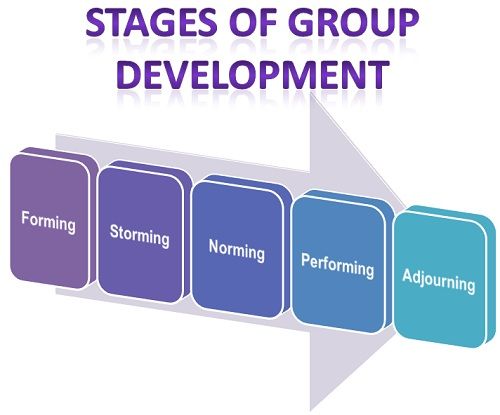Definition: The Group Development means, forming the association of people to work as a group and direct their actions towards the accomplishment of a common goal. The jobs of each group member are interdependent and hence the performance of one will affect the entire group’s performance. It is often called as a team building or team development.
The most famous and a well-known model of group development was proposed by Bruce Tuckman, that included four stages Viz, forming, storming, norming, performing and later the fifth stage adjourning was added to this model.
Tuckman’s Stages of Group Development
- Forming: At this stage, the formation of a new group begins, wherein the members come together and get to know each other through the interactions. Here the individuals are excited and anxious to know about the scope of the task and the ways to approach it. Generally, the individuals come with a desire to get accepted by others and avoid controversy or conflicts.
- Storming: Once the forming stage is over, the individuals will start interacting with each other in the context of the task to be achieved. The conflict and competition among the group members will be highest at this stage.
The most dominant group members come in the front while the confrontational members remain silent and continue to be in the security or calm stage (forming). The issues related to the leadership, responsibility, strategies, rules, authority, evaluation, reward system, etc. arises at the storming stage.
- Norming: Once the role of every member is cleared along with the authority and responsibility of each, the team members start settling in a group. Here, everybody works cohesively towards the target and appreciate each other’s experience and skills.
- Performing: At this stage, synergy gets created between the team members, where everyone works towards the accomplishment of a goal. This stage is characterized by flexibility and interdependence. The team members know each other so well that they can handle any complex problem that comes before the team.
Also, the roles and responsibilities of member changes according to the situation frequently, because at this stage everyone is equally a task-oriented and people-oriented and thus can perform efficiently.
- Adjourning: This is the last stage of group development, where the group is terminated, and the group members are separated from each other. Every group is created for a purpose, and once the purpose is fulfilled the group is adjourned.
Some authors call this stage as “mourning or deforming,” because, the sense of loss is felt by the group members, at the time of separation from each other.
Thus, the researchers study about the group development to determine the changes that occur within the group.


Sarah says
Who wrote this article please reply to the comment as soon as possible on my email
Terri Eason says
Who wrote this article. Please respond as soon as possible.
Surbhi S says
The article is written on 16 December 2015, by Megha M.